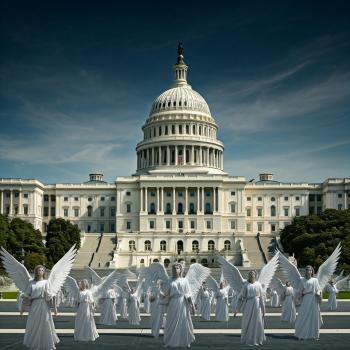Editor’s Note: This is the third in a weekly Lenten series on the body and blood of Christ by Church History Professor Kelly Pigott.
 When the early Christians walked into the room where worship took place, the focal point was a table—not a pulpit, or a baptistery, or a cross, or a computer screen, or a drum set—a table. In one service called an “Agape meal,” they served food like at a covered-dish supper, and at the end of the evening celebrated communion, which was at the heart of their worship experience. The practice was simple, spontaneous, joyous, and deeply meaningful. The altar/table was where one communed with Jesus by remembering his sacrifice, by recognizing his presence in the room, and by looking forward to the day when all the church would gather with her groom at the messianic banquet.
When the early Christians walked into the room where worship took place, the focal point was a table—not a pulpit, or a baptistery, or a cross, or a computer screen, or a drum set—a table. In one service called an “Agape meal,” they served food like at a covered-dish supper, and at the end of the evening celebrated communion, which was at the heart of their worship experience. The practice was simple, spontaneous, joyous, and deeply meaningful. The altar/table was where one communed with Jesus by remembering his sacrifice, by recognizing his presence in the room, and by looking forward to the day when all the church would gather with her groom at the messianic banquet.
But over the decades and then centuries, the Lord’s Supper morphs. To some degree, this is understandable and necessary. But what I find tragically ironic is how quickly the church strayed from the simple meanings surrounding the altar/table to emphasize practices that communicated almost the exact opposite of what appears to be the original intent.
To begin with, one of the scant texts in the New Testament describing how early Christians practiced the Lord’s Supper specifically mentions that bringing the church together was a major purpose behind communion. “Because there is one loaf, we who are many, are one body, for we all partake of the one loaf” (I Cor. 10:17, NIV). This became so important to the early church that as congregations outgrew their initial meeting places and resorted to satellite groups around town, the bishop baked one huge loaf of bread (called the “fragmentum”) which he then distributed to each home as a sign that though the church met at different locations, they were still a unified body. And it’s clear from the picture of the first Lord’s Supper that Jesus celebrated with his disciples that, more than anything, Jesus meant for the meal to be a moment of grace. Just look at the group he gathered that night. It’s safe to say that all of them were having doubts about Jesus, especially after a very challenging week where just about everyone, except those gathered in the room, had abandoned Jesus. And for some, the disillusionment was beginning to take its toll. And yet, they were all invited to this meal where Jesus stood and said, “This is my body, broken for you…. This is my blood, shed for you.” Jesus offered himself body and blood, bread and wine, to a group of skeptics, sinners, apostates, and one downright enemy. And then he commanded the church to “do this in remembrance of me.”
Unfortunately, it didn’t take very long for the church to forget. As early as the 2nd century, a document entitled the The First Apology written by Justin Martyr detailed some of the initial stipulations put on those who could participate in the Lord’s Supper. “And this food is called the Eucharist, of which no one is allowed to partake but the man who believes that the things which we teach are true, and who has been washed with the washing that is for the remission of sins, and unto regeneration, and who is so living as Christ has enjoined.” In other words, despite the unworthiness of the initial group at the Lord’s table, now the church started to demand that people demonstrate their worthiness by being baptized (which took up to three years of instructions before occurring), by passing a doctrinal test, and by proving that they were living a moral life (i.e., no sinners allowed).
Had Jesus demanded this, he would have been eating alone.
But it gets worse. In the late 2nd century, Victor of Rome wanted to withhold communion from those who celebrated Easter on the 14th of Nissan instead of on Sunday like the rest of the church. Fortunately, he was forced to back down. But in the second and third centuries, one could permanently be denied communion for certain sins, like fornication, idolatry, or watching Harry Potter movies (well, actually dabbling in magic).
And after Christianity became the dominant religion of the empire, communion was used to make political statements. When an angry mob of Christians destroyed a Jewish synagogue at Callinicum, Emperor Theodosius wrote to the bishop and demanded that he punish the rioters and make them build another synagogue. The following Sunday, Theodosius’s pastor, Ambrose, preached a sermon directed at the emperor with the following three points and a poem:
1) Jews are heretics
2) Heretics deserve to have their places of heresy destroyed
3) It’s immoral for Christians to use their resources to build buildings for heretics.
And anyone who disagrees with what I just said
Next Sunday, will not receive the wine and the bread.
OK, I made the poem up. But the threat was real, and Theodosius was forced to repent. And now the Lord’s Supper is used to discipline members of the congregation who not only get out of line theologically or morally, but who also make political decisions the pastor doesn’t like
But it gets worse. As worship gets far more formalized, communion becomes a privilege restricted to only orthodox, baptized believers who have properly consecrated themselves. The means of consecration becomes increasingly strict, limiting the number of people “worthy” to partake. Granted, the strictness of this practice varied by location, but more and more communion was viewed as a blessing only for the spiritual elite. As a result, communion was celebrated less and less by the masses. Before long, the average congregant was celebrating communion only on popular holy days.
But it gets worse. Fairly soon, a fear developed among the masses that someone might accidently spill the blood of Christ on the floor, a risk considered too great to take. More and more, only the religious professionals were brave enough to sip from the cup. And eventually, this turned into a formal rule where only clerics were given access to the cup, thus denying the average worshiper a chance to obey Christ’s command to “take and drink.”
It appears they weren’t “taking and eating” much, either. In the fifth century, church leaders actually discussed whether one could be called a “Christian” if one didn’t take communion at least once a year.
Despite efforts of reform, participation in communion among average laypeople became more of a rarity during the Middle Ages. And as the Renaissance began, and the veneration of relics became big business, the Eucharist became part of an economic system designed to both exclude and exploit sinners at the same time, enraging a little-known Augustinian monk who decided to do something about it.
You may have heard of him–Martin Luther.
Photo credit: wideonet/Shutterstock.com
 Kelly Pigott is a church history professor who teaches at Hardin-Simmons University in Abilene, Texas. You can find more musings on history, culture, contemplative spirituality and theology, along with interviews with authors at kellypigott.com. Follow him on twitter @kellypigott
Kelly Pigott is a church history professor who teaches at Hardin-Simmons University in Abilene, Texas. You can find more musings on history, culture, contemplative spirituality and theology, along with interviews with authors at kellypigott.com. Follow him on twitter @kellypigott













